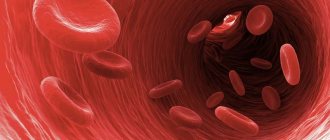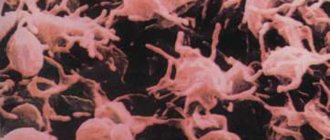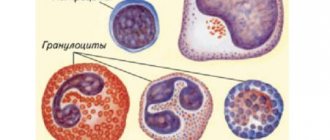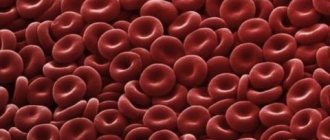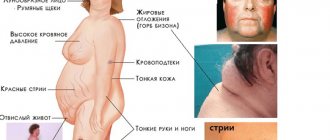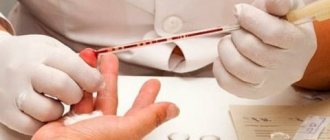Why do humans need neutrophils?
Segmented neutrophils make up the largest portion of immune cells. They are destroyed when pathogenic organisms are destroyed. To eliminate the infection, many leukocytes are needed, including segmented cells.
There are two types of neutrophils:
- Immature staphylocytes. The cell nucleus is in the form of a bacillus, i.e. not fully formed, so they are not suitable for combating pathogens.
- Nuclear segment - fully matured components. They are able to fight infections and inflammation. Leukocyte activation also occurs during tumor formation.
If a blood test shows a low content of neutrophils, most often this indicates the active development of an infectious process. This condition is called neutropenia.
If the level of segmented neutrophils deviates from the norm, the following pathologies are suspected:
- Leukemia.
- Thrombocytopenia.
- Blood failure.
- Avitaminosis.
- Oncological changes in the bone marrow or metastases in the bone marrow.
- Stomach or intestinal ulcers.
- Infectious process.
- Anaphylactic shock.
- Body poisoning.
- Complications resulting from radiation therapy.
What does a decrease in the rate in women mean?
A decrease in segmented neutrophils is discovered accidentally during a routine visit to a gynecologist in a woman, which most likely indicates the presence of a chronic, sluggish urogenital infection caused by specific pathogens.
In addition to the above-mentioned banal reason, women can develop all of the diseases listed above. Therefore, if segmented neutrophils are reduced in a blood test, then specialists - a therapist, gynecologist, infectious disease specialist, hematologist - must draw a conclusion about what they are.
Blood levels
The number of segmented cells should be 40-68% of the total, and the number of stably nuclear cells should be about 5%.
The following standards are distinguished:
- In children under 1 year of age - 1.8-8.4, which is 30-50%.
- From 1 to 7 years - 2-6.0 (35-55%).
- From 7 to 12 years - 2.2-6.5 (40-65%).
- In adults 1.8-6.5 (45-70%).
If the number of neutrophils in the blood decreases, neutropenia is diagnosed. The number of cells in the bone marrow decreases, which negatively affects the immune system.
The norm depends on the age of the patient; it is the same for men and women.
Suspicion of pathology is manifested by the following symptoms:
- Increased work of sweat glands.
- Heart problems.
- Weight loss.
- Increased emotionality.
Segmented neutrophils: norms in adults and children
As we have already said, the proportion of segmented neutrophils as a result of a blood test is displayed as a percentage (%) in relation to other forms of leukocytes.
In adult women and men, the blood should normally contain from 47 to 72% segmented neutrophils.
In a child in the first days of life, the proportion of neutrophils ranges from 51 to 72%, and lymphocytes – 16-34%. On the 4th-6th day of life in the infant, the ratio of leukocytes changes and the first crossover of the leukocyte formula occurs: band and segmented neutrophils decrease, and lymphocytes increase, as a result of which their proportion becomes approximately the same and amounts to an average of 45% each.
The transformation of the leukocyte formula does not stop there. At one month, band and segmented neutrophils in the child’s blood are reduced to 25-30% and lymphocytes are increased to 60-65%. In this form, the leukocyte formula lasts up to a year, after which the number of lymphocytes gradually drops to 20-40% and the number of neutrophils increases to 60-70%.
Thus, the leukocyte formula in children from 12 months to three years is as follows:
- basophils – from 0 to 1%;
- band neutrophils – from 0 to 1%;
- segmented neutrophils – from 32 to 50%;
- eosinophils – from 1 to 4%;
- lymphocytes – from 38 to 58%;
- monocytes from – 10 to 12%.
Children are also characterized by a second cross-section of the leukocyte formula, which is noted at four to five years of age, when the numbers of neutrophils and lymphocytes are at the same level. After five years, the proportion of neutrophils increases and can range from 60 to 70%, and lymphocytes decreases and corresponds to 20-40%.
After the second cross-section of the leukocyte formula, children over five years of age should have the following white blood indicators:
- basophils – from 0 to 1%;
- band neutrophils – from 0 to 1%;
- segmented neutrophils 36-52%;
- eosinophils – from 1 to 4%;
- lymphocytes – from 33 to 50%;
- monocytes – from 10 to 12%.
Causes of decline in adults
The disease can be congenital, acquired and chronic. The latter form can be observed in a child after two years of age. This is temporary and then returns to normal.
The reasons for the decrease in the number of neutrophils are as follows:
- Heredity. Symptoms appear in the baby immediately after birth or in the first weeks of life (furunculosis, abscess, pneumonia).
- Bacterial infection (angina, sepsis, phlegmon, pyelonephritis and others).
- Tissue necrosis (burns, gangrene, tumors)
- Various poisons.
- Metabolic disorders (diabetes mellitus, gout, etc.).
- Serious blood disorders.
- Irradiation.
- Anaphylactic shock.
- Frequent use of analgin, penicillin.
- Excessive physical and emotional stress.
- Exhaustion of the body.
It has been noted that with a reduced level of neutrophils in a general blood test, diseases such as acute respiratory infections, influenza, dysbiosis of the digestive system and oral cavity, and various inflammatory processes occur more often.
Acute neutropenia is usually detected after chemotherapy. This increases the risk of bacterial and fungal pathologies. Drugs prescribed for cancer and autoimmune diseases also become provocateurs.
Functions of segmented neutrophils
Segmented neutrophils.
They are essential for the human body. The main function of these cells is to protect the human body from various infections, bacteria, and fungi.
Neutrophils carry out phagocytosis in the body, that is, they “attack,” “absorb,” and destroy harmful particles in blood cells and tissues. Their peculiarity is that they not only “swim” on the blood, but also release “legs”. In this case, they move towards foreign objects with amoeba-like movements. They seem to roll over from one part to another.
Neutrophils, approaching the source of infection, envelop the bacteria and destroy them, and themselves die. In this process, they release a substance into the blood that attracts other cells to the area. If the wound has suppuration, then millions of leukocytes die.
Important! The level of neutrophils in the blood needs to be monitored regularly, since any deviation from the normal number is an alarm beacon indicating the presence of the disease. If neutrophils are reduced, then there is an infection.
Reasons for low values in children
The provocateur of low values in children is:
- A large number of cells die while performing their protective functions.
- Their production in the bone marrow leaves much to be desired.
- Cell death in pathologies of the hematopoietic organs.
- Anaphylactic shock.
- Viral infections: measles, acute respiratory infections, rubella, hepatitis, etc.
- Malemia.
- As a result of radiation therapy.
- Use of anticonvulsants and analgesics.
- Poisoning.
- Fungal diseases.
There are often cases where the number of neutrophils is low and the number of lymphocytes is high. This indicates the presence of a virus. This is observed in the following diseases:
- Viral diseases.
- Tuberculosis.
- Thyroid diseases.
- HIV.
- Blood cancer.
Measures should be taken to restore immunity. If the illness lasts for a long time, the doctor prescribes repeated blood tests and additional diagnostic procedures for the child.
The most dangerous is Kostman's genetic neutropenia, when there are no neutrophils at all. Children under one year of age are at risk; later, the body is protected by monocytes and eosinophils.
The concept of neutrophils and their types
Neutrophils are one of the types of leukocytes or, as they are also called, white blood cells. They are divided into stages of development into:
- Rods. These are early neutrophils that do not have a nucleus;
- Segmented. They have a complete nucleus and are considered mature.
Initially, the neutrophil originates in the bone marrow; after maturing to the stab state, it enters the circulatory system. After a certain time, it is divided into several separate segments. It is at this stage that it enters a mature state, that is, it becomes segmented and has a formed nucleus. The latter penetrates the walls of blood vessels of all organs over a period of time from 2 to 5 hours. Here he begins to perform his functions. Let's look at them.
Treatment of neutropenia
To prescribe the necessary therapy, the doctor needs to know exactly the cause that triggered the failure. A decrease in the number of segmented cells is not an independent disease, but a symptom of an existing disease:
- If the pathology arises as a result of an infectious process, it is necessary to prescribe antibiotics to which the pathogens are not resistant. The first symptom is an increase in body temperature.
- If heredity plays a role, the most effective growth factors will be those that increase the number of protective blood cells.
- For allergic reactions and autoimmune disorders, hormones and corticosteroids must be used.
- If the cause is an enlarged spleen, surgery (removal) is advisable.
- For anemia, immunosuppressants must be used. If there is no result, a bone marrow transplant is performed, but after the procedure numerous complications are possible and a long recovery period is required.
- If medications were the cause of the abnormality, they should be discontinued. This is usually enough for recovery.
- After chemotherapy for tumor diseases, a decrease in the number of segmented neutrophils is observed in almost 100% of cases. However, one should not refuse the procedure, as it is associated with the risk of further tumor development and the appearance of metastases. In such situations, the specialist prescribes measures to normalize the NEU. The most popular are filgrastim and pegfilgrastim, which are very effective in increasing the number of protective cells.
Restoring performance with diet
Doctors recommend a proper diet to help restore neutrophil levels. The diet should include:
- Lean meat and fish.
- Wholemeal bread.
As well as foods rich in folic acid:
- Beans.
- Italian nuts.
- Kale.
- Buckwheat grain.
- Peanut.
- Pomegranate.
- Grapefruit.
Iron-rich foods are also needed:
- Liver.
- Strawberries and blueberries.
- Raw carrots.
- Quail and chicken eggs.
Danger occurs when the number of neutrophils does not return to normal within 6 months. In these cases, the immune system does not work properly and infections and pathogens easily enter the body.
They cause various pathologies that can lead to death or the development of tumors.
Segmented neutrophils are reduced in a child: reasons
A decrease in neutrophils in the blood in children can have more serious consequences than in adults, since the child’s body is just developing and is more sensitive to various infections.
The causes of segmented neutropenia in children may be the same as in adults. But there are some differences to note.
- Long-term segmented neutropenia can be triggered by childhood infections such as chickenpox, measles, rubella, and mumps.
- Tuberculosis can also affect the state of the leukocyte formula. With this disease, segmented neutrophils decrease and lymphocytes increase.
- Anemia due to vitamin B12 deficiency or iron deficiency plays a significant role in the development of neutropenia in children.
- In addition to the above, the number of segmented neutrophils may decrease due to fatigue, psycho-emotional shock, teething, or after vaccination.
Treatment of segmented neutropenia depends on the cause that led to the imbalance of the leukocyte formula. Therefore, having received a blood result in which the number of segmented neutrophils is reduced, adults need to consult a general practitioner, and the child should be shown to a pediatrician.
After a comprehensive examination of the body, the doctor will determine the cause of neutropenia, prescribe treatment or refer you to the appropriate specialist. Only a specialist will be able to make an accurate diagnosis and select effective, and most importantly, safe treatment.
Preventive measures
In order for the study to show the norm of segmented neutrophils, it is necessary to strengthen the immune system:
- Follow an optimal daily routine and eat a healthy diet.
- Experts recommend getting vaccinated against flu and other ailments in advance, not only for children, but for every adult.
- Carry out hardening procedures regularly.
- When washing your face, rinse your nose with warm water. This procedure helps cleanse the mucous membranes and villi, which increases protection.
If your immune system is low, you should:
- Be sure to perform hygiene procedures before eating, after using the toilet and in public places.
- Shower daily.
- Clean your mouth and throat constantly.
- Wear rubber gloves when handling detergents and chemicals.
Additionally, men are advised to use electric razors to avoid cuts and prevent bacteria from entering the wound. Sexual activity is not recommended if the body's defenses are abnormally low.



